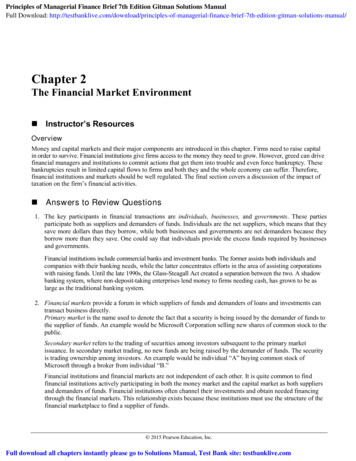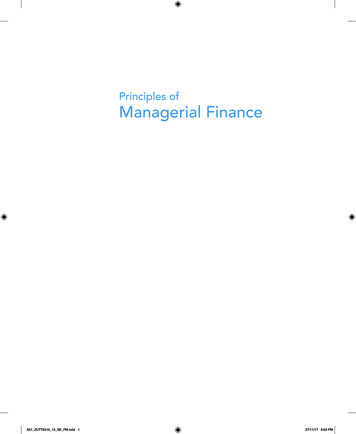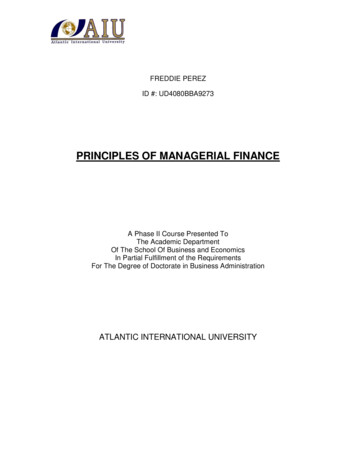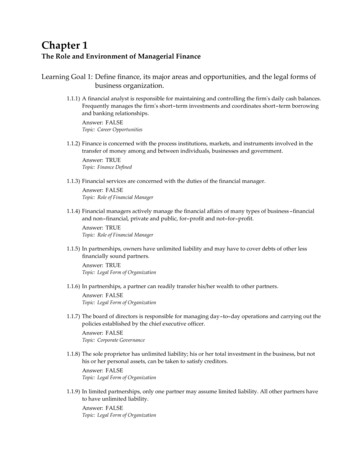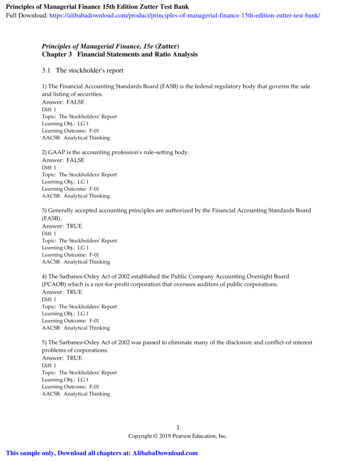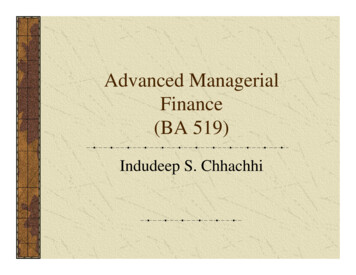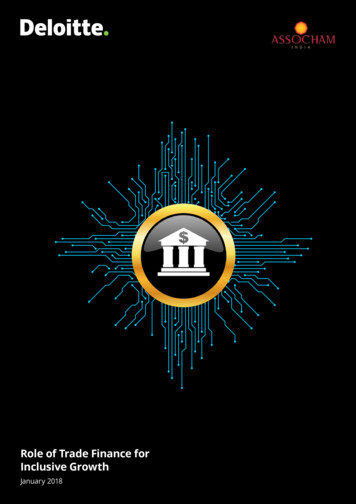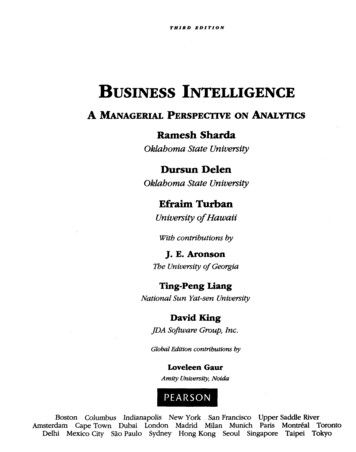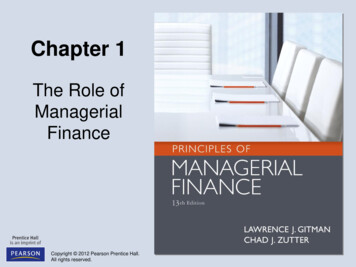
Transcription
Chapter 1The Role ofManagerialFinanceCopyright 2012 Pearson Prentice Hall.All rights reserved.
COURSE DESCRIPTIONBusiness Finance is an examination of theprinciples, theory and techniques ofmodern corporate financial management.Topics such as risk, return, valuation ofsecurities and projects, long-term financingand the financial environment areexplored.
COURSE MATERIALSTextbooks–Gitman, Lawrence J., Chad J. Zutter, (2012) Principles of Managerial Finance (13th ed.) Addison-Wesley,Reading MA.–PearsonMyLab add-inSupplemental Materials–Notes and homework documents are accessed from www.tmcfinancenotes.weebly.com Web Exercises are identified in word documents. They are to be emailed to the instructor.–Materials should be downloaded as necessary for the classes–A laptop will be very beneficial in completing in class activities.Computing / Software–It is assumed that all students have a basic understanding of the use of Excel spreadsheet.–There is an Excel spreadsheet to download from the Handout section of MYTMC.–All individual homework and exams are completed via PearsonMyLab
GRADE COMPOSITION(TRADITIONAL)Exams55%Individual Homework35%Attendance and Participation10%Grades are based on the total number of correctpoints achieved out of the total possible.The above percentages represent an approximatedistribution of the grading.
GRADE COMPOSITION (TAP)Exams50%Individual Homework15%Group Homework10%Individual Web Exercises15%Attendance and Participation10%Grades are based on the total number of correct points achieved out of the totalpossible.The above percentages represent an approximate distribution of the grading.
HomeworkHomework is due the week after the chapter iscompletely covered in class.– There may be times when we do not get everything inthe session covered. The chapter homework is only dueafter the chapter is completed.– Chapter assignments are due before the next class. Allindividual homework will be completed on line.– Group assignments are emailed to the instructor Be sure to name the file correctly.– Late assignments will receive a 10% penalty.Copyright 2009 Pearson Prentice Hall. All rights reserved.1-6
ExamsAll exams are completed online.You will be directed to the PearsonMyLab website for completion of homework andexam requirements.You have approximately 3 minutes per question. (All multiple choice)Chapters are examined after each is completed.Once you start the exam the clock is running. You cannot stop and comeback.– Give yourself plenty of time to complete the exam.The exam must be completed by 8PM the day before the next class meeting.– As soon as the exam is completed you will receive your score.– Review of the questions cannot take place until after the deadline has passed.Any technology challenges should be emailed ASAP.Copyright 2009 Pearson Prentice Hall. All rights reserved.1-7
What is Finance? Finance can be defined as the science and art of managingmoney. At the personal level, finance is concerned withindividuals’ decisions about how much of their earningsthey spend, how much they save, and how they investtheir savings. In a business context, finance involves the same types ofdecisions: how firms raise money from investors, howfirms invest money in an attempt to earn a profit, and howthey decide whether to reinvest profits in the business ordistribute them back to investors. 2012 Pearson Prentice Hall. All rights reserved.1-8
Career Opportunities inFinance: Managerial Finance Managerial finance is concerned with the duties of the financialmanager working in a business. Financial managers administer the financial affairs of all types ofbusinesses—private and public, large and small, profit-seeking andnot-for-profit. Planning Financing Investing Very involved with strategic planning and implementation 2012 Pearson Prentice Hall. All rights reserved.1-9
Managerial Finance (cont.) The recent global financial crisis and subsequentresponses by governmental regulators, increased global competition, Increased rapid technological change increased the importance and complexity of the financialmanager’s duties. increased demand for financial experts who can manage cash flows in different currencies protect against the risks that naturally arise from internationaltransactions. 2012 Pearson Prentice Hall. All rights reserved.1-10
Legal Forms of BusinessOrganization A sole proprietorship is a business owned by one personand operated for his or her own profit. A partnership is a business owned by two or morepeople and operated for profit. A corporation is an entity created by law. Corporationshave the legal powers of an individual in that it can sueand be sued, make and be party to contracts, and acquireproperty in its own name. Finance theories and techniques apply to all. 2012 Pearson Prentice Hall. All rights reserved.1-11
What is the Goal of the firm? Is there a benchmark that serves as anappropriate measure of whether an actionshould proceed or not? Maximize profit Minimize expenses Maximize marketing share Maximize share price Maximize stakeholder wealth 2012 Pearson Prentice Hall. All rights reserved.1-12
Goal of the Firm:Maximize Profit?Which Investment is Preferred?Profit maximization may not lead to the highest possible share pricefor at least three reasons:1.Timing is important—the receipt of funds sooner rather than later is preferred2.Profits do not necessarily result in cash flows available to stockholders3.Profit maximization fails to account for risk 2012 Pearson Prentice Hall. All rights reserved.1-13
Goal of the Firm:Maximize Shareholder Wealth!!!Why?Because maximizing shareholder wealth properly considerscash flows, the timing of these cash flows, and the risk ofthese cash flows.– This is primarily what the owners wantThis can be illustrated using the following simple stockvaluation equation:level & timingShare Price Future DividendsRequired Return 2012 Pearson Prentice Hall. All rights reserved.of cash flowsrisk of cashflows1-14
Goal of the Firm:What About Stakeholders? Stakeholders are groups such as employees, customers,suppliers, creditors, owners, and others who have a directeconomic link to the firm. A firm with a stakeholder focus consciously avoidsactions that would prove detrimental to stakeholders. Thegoal is not to maximize stakeholder well-being but topreserve it. Such a view is considered to be "socially responsible." 2012 Pearson Prentice Hall. All rights reserved.1-15
The Role of Business Ethics Business ethics are the standards of conduct or moraljudgment that apply to persons engaged in commerce. Violations of these standards in finance involve a varietyof actions: “creative accounting,” earnings management,misleading financial forecasts, insider trading, fraud,excessive executive compensation, options backdating,bribery, and kickbacks. Negative publicity often leads to negative impacts on afirm 2012 Pearson Prentice Hall. All rights reserved.1-16
The Role of Business Ethics:Ethics and Share PriceEthics programs seek to:– reduce litigation and judgment costs– maintain a positive corporate image– build shareholder confidence– gain the loyalty and respect of all stakeholdersThe expected result of such programs is to positively affectthe firm’s share price.Is there a place in business for the “Golden Rule”? 2012 Pearson Prentice Hall. All rights reserved.1-17
Managerial Finance Function:Relationship to Economics Financial managers must understand the economicframework and be alert to the consequences of varyinglevels of economic activity and changes in economicpolicy. They must also be able to use economic theories asguidelines for efficient business operation. Marginal cost–benefit analysis is the economic principlethat states that financial decisions should be made andactions taken only when the added benefits exceed theadded costs 2012 Pearson Prentice Hall. All rights reserved.1-18
Managerial Finance Function:Relationship to Accounting The firm’s finance and accounting activities are closelyrelated and generally overlap. One major difference in perspective and emphasisbetween finance and accounting is that accountantsgenerally use the accrual method while in finance, thefocus is on cash flows. 2012 Pearson Prentice Hall. All rights reserved.1-19
Managerial Finance Function:Relationship to Accounting (cont.)Sales 100,000 (1 yacht sold, 100% still uncollected)Costs 80,000 (all paid in full under supplier terms)Income Statement SummaryAccrual basisSalesLess: CostsNet Profit/(Loss) 2012 Pearson Prentice Hall. All rights reserved. 100,000(80,000) 20,000Cash basis 0(80,000) (80,000)1-20
Managerial Finance Function:Relationship to Accounting (cont.)Finance and accounting also differ with respect to decisionmaking:– Accountants devote most of their attention to the collection andpresentation of financial data.– Financial managers evaluate the accounting statements, developadditional data, and make decisions on the basis of theirassessment of the associated returns and risks. 2012 Pearson Prentice Hall. All rights reserved.1-21
Governance and Agency:Corporate Governance Corporate governance refers to the rules, processes, andlaws by which companies are operated, controlled, andregulated. It defines the rights and responsibilities of the corporateparticipants such as the shareholders, board of directors,officers and managers, and other stakeholders, as well asthe rules and procedures for making corporate decisions. 2012 Pearson Prentice Hall. All rights reserved.1-22
Governance and Agency:Individual versus Institutional Investors Individual investors are investors who own relatively smallquantities of shares so as to meet personal investment goals. Institutional investors are investment professionals, such as banks,insurance companies, mutual funds, and pension funds, that are paidto manage and hold large quantities of securities on behalf of others. Unlike individual investors, institutional investors often monitor anddirectly influence a firm’s corporate governance by exerting pressureon management to perform or communicating their concerns to thefirm’s board. Not historically the way the world worked. This has helped individualinvestors by giving some assurance as to confidence of management andstheir actions. 2012 Pearson Prentice Hall. All rights reserved.1-23
Governance and Agency:Government RegulationThe Sarbanes-Oxley Act of 2002: established an oversight board to monitor the accounting industry; tightened audit regulations and controls; toughened penalties against executives who commit corporate fraud; strengthened accounting disclosure requirements and ethical guidelines forcorporate officers; established corporate board structure and membership guidelines; established guidelines with regard to analyst conflicts of interest; mandated instant disclosure of stock sales by corporate executives; increased securities regulation authority and budgets for auditors and investigators. 2012 Pearson Prentice Hall. All rights reserved.1-24
Governance and Agency:The Agency Issue A principal-agent relationship is an arrangement inwhich an agent acts on the behalf of a principal. Forexample, shareholders of a company (principals) electmanagement (agents) to act on their behalf. Agency problems arise when managers place personalgoals ahead of the goals of shareholders. Agency costs arise from agency problems that are borneby shareholders and represent a loss of shareholderwealth. 2012 Pearson Prentice Hall. All rights reserved.1-25
The Agency Issue:The Agency ProblemWhenever a manager owns less than 100% of the firm’sequity, a potential agency problem exists.In theory, managers would agree with shareholder wealthmaximization.However, managers are also concerned with their personalwealth, job security, fringe benefits, and lifestyle.This would cause managers to act in ways that might notalways benefit the firm shareholders. 2012 Pearson Prentice Hall. All rights reserved.1-26
The Agency Issue: How can we get managers to act in shareholder bestinterests? Labor market for employment Labor market for takeovers Auditing the companies books Compensation plans Incentive plans tie management compensation to share price; oneexample involves the granting of stock options. Performance plans tie management compensation to measures such asEPS or growth in EPS. 2012 Pearson Prentice Hall. All rights reserved.1-27
Options Option is the right to buy a stock at a certainprice within a certain period of time.– Creates another place for people to acquirecompany stock.You have an optionto buy a share ofstock at 50. Thecurrent price is 35.Where would you buy? 2012 Pearson Prentice Hall. All rights reserved.You have an option to buy ashare of stock at 50. Afterseveral years of goodmanagement the price hasrisen to 65.Where would you buy?1-28
Matter of Fact—Forbes.comCEO Performance vs. Pay 2012 Pearson Prentice Hall. All rights reserved.1-29
Managerial Finance Function: Relationship to Accounting The firm’s finance and accounting activities are closely-related and generally overlap. One major difference in perspective and emphasis between f
